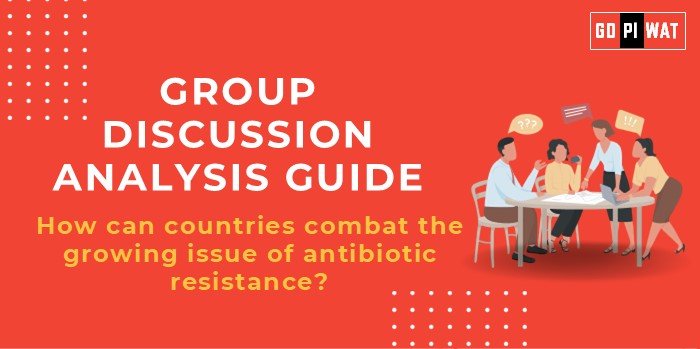📋 Group Discussion (GD) Analysis Guide
🦠 Topic: How can countries combat the growing issue of antibiotic resistance?
🌐 Introduction to Antibiotic Resistance
Context Setting: “Antibiotic resistance is a global health crisis that undermines decades of medical advancements, affecting everything from routine surgeries to cancer treatments.”
Topic Background: The phenomenon occurs when bacteria evolve to resist the effects of antibiotics, rendering standard treatments ineffective. Misuse and overuse of antibiotics in humans and livestock, coupled with a slow development pipeline for new antibiotics, exacerbate the problem.
📊 Quick Facts and Key Statistics
- Global Death Toll: Over 1.27 million deaths annually are directly attributed to antibiotic resistance (WHO, 2023).
- Economic Impact: By 2050, antibiotic resistance could cost the global economy $100 trillion (World Bank).
- Antibiotics in Agriculture: 70% of antibiotics are used in livestock farming, contributing significantly to resistance.
- Development Gap: Only a few new antibiotics have been approved in the last decade, far fewer than needed.
👥 Stakeholders and Their Roles
- Governments: Policy implementation, surveillance systems, and funding for research.
- Healthcare Providers: Rational prescription practices and patient education.
- Pharmaceutical Companies: Developing new antibiotics and alternatives.
- Farmers and Agribusinesses: Reducing antibiotic usage in livestock.
- International Organizations: WHO and FAO facilitate global coordination and awareness.
🏆 Achievements and Challenges
- Achievements:
- Global Action Plans: Over 100 countries have national strategies to combat resistance.
- Regulatory Measures: The EU banned preventive use of antibiotics in farming.
- Awareness Campaigns: WHO’s World Antibiotic Awareness Week has increased global awareness.
- Challenges:
- Overuse in Healthcare: Antibiotics prescribed unnecessarily for 30–50% of cases.
- Lack of Innovation: Pharmaceutical companies face economic barriers in antibiotic R&D.
- Global Disparity: Resource-limited countries lack robust surveillance and regulation.
🌍 Global Comparisons and Case Studies
- Sweden: Success through strict antibiotic policies and extensive education campaigns.
- India: Faces high resistance rates due to widespread misuse and over-the-counter availability.
- Netherlands: Reduced antibiotic use in agriculture by 60% through mandatory targets and farmer incentives.
📜 Structured Arguments for Discussion
- Supporting Stance: “Antibiotic resistance can be tackled effectively with comprehensive global strategies, as seen in Sweden and the Netherlands.”
- Opposing Stance: “Despite efforts, global inequities and lack of new drugs make resistance an inevitable crisis.”
- Balanced Perspective: “While progress is evident, the fight against resistance requires sustained global cooperation and significant investments.”
💡 Effective Discussion Approaches
- Opening Approaches:
- Statistics-Based: “Antibiotic resistance claims over a million lives annually, highlighting the urgency of coordinated action.”
- Comparative Insight: “Countries like Sweden have shown how stringent regulations can dramatically reduce resistance.”
- Counter-Argument Handling:
- Example: When someone highlights the lack of progress, emphasize successful case studies like the Netherlands and discuss scalability.
🔍 Strategic Analysis of Strengths and Weaknesses
- Strengths: Global recognition of the issue; increasing innovation in diagnostics.
- Weaknesses: High R&D costs deter pharmaceutical investment; widespread misuse in low-resource settings.
- Opportunities: Develop rapid diagnostic tools; promote international funding initiatives.
- Threats: Emergence of pan-resistant bacteria; economic burden on healthcare systems.
🎓 Connecting with B-School Applications
- Real-World Applications: Public health management, global supply chain considerations, and policy innovation.
- Sample Questions:
- “How can India strengthen its antibiotic resistance strategy?”
- “Discuss the role of innovation in combating antibiotic resistance.”
- Insights for Students: Explore topics like health economics, innovation barriers, and public-private partnerships in healthcare.


